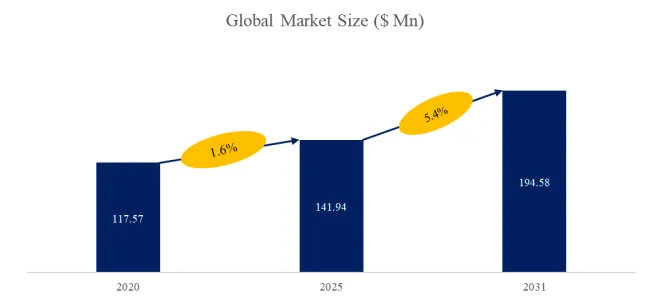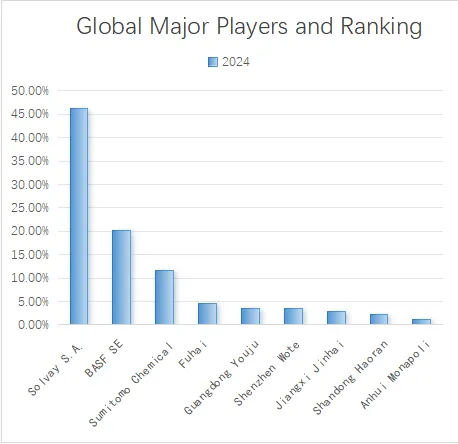Right Now
Polysulfone for membrane Research:CAGR of 5.4% during the forecast period
QY Research Inc. (Global Market Report Research Publisher) announces the release of 2025 latest report “Polysulfone Resin for RO Membrane- Global Market Share and Ranking, Overall Sales and Demand Forecast 2025-2031”. Based on current situation and impact historical analysis (2020-2024) and forecast calculations (2025-2031), this report provides a comprehensive analysis of the global Wire Drawing Dies market, including market size, share, demand, industry development status, and forecasts for the next few years.
The global market for Polysulfone Resin for RO Membrane was estimated to be worth US$ 35.5 million in 2024 and is forecast to a readjusted size of US$ 52.2 million by 2031 with a CAGR of 5.8% during the forecast period 2025-2031.
【Get a free sample PDF of this report (Including Full TOC, List of Tables & Figures, Chart)】
https://www.qyresearch.com/reports/4700812/polysulfone-resin-for-ro-membrane
Polysulfone for membrane Market Summary
Polysulfone membrane is a high-performance membrane material widely used in various separation and filtration applications. Its composition primarily includes polysulfone resin and other additives, offering excellent physical, chemical, and mechanical properties. Polysulfone resin can be processed via solvent-based techniques to produce ultrafiltration (UF), osmosis, reverse osmosis (RO), and hollow fiber membranes with high mechanical strength. These products are utilized in energy-saving and water treatment applications, among others.
Thanks to its outstanding chemical stability, mechanical strength, high-temperature resistance, and film-forming properties, polysulfone for membranes has become a core material in the separation membrane industry. It is widely applied in reverse osmosis (RO), ultrafiltration (UF), microfiltration (MF), nanofiltration (NF), and biomedical membranes. In RO membranes, polysulfone typically serves as a support layer, forming a porous structure via phase inversion to provide mechanical reinforcement for the polyamide active layer. Its high-pressure and chlorine resistance significantly enhance the durability of RO membranes in seawater desalination and wastewater treatment. Meanwhile, UF and MF membranes use polysulfone as the base material, leveraging its controllable pore size distribution (UF: 1–100 nm, MF: 0.1–10 μm) and antifouling properties for applications in food and beverage purification, pharmaceutical separation, and industrial wastewater treatment. For NF membranes, polysulfone can be modified via interfacial polymerization or blending to adjust surface charge and nanoscale pore size (1–10 nm), enabling selective retention of divalent ions and small organic molecules, making it highly effective in water softening and dye desalination.
In biomedical applications, polysulfone membranes’ biocompatibility and sterilizability (via gamma irradiation or steam sterilization) make them ideal for hemodialysis, artificial lungs, and drug delivery systems. For instance, hollow-fiber polysulfone dialysis membranes efficiently remove uremic toxins while retaining albumin due to their precisely engineered pore structure. Hydrophilically modified polysulfone membranes further reduce platelet adhesion, improving blood compatibility. Additionally, polysulfone shows potential in gas separation and fuel cell proton-exchange membranes, though sulfonation or nanofiller composites may be required to enhance selectivity or conductivity.
Despite challenges such as hydrophobicity-induced fouling (mitigatable via PEG grafting or amphiphilic copolymer modification), polysulfone membranes remain indispensable in separation technologies due to their overall performance. Future trends will focus on green solvent-based film-forming processes, smart responsive membranes (e.g., pH-/temperature-sensitive types), and emerging applications such as 3D-printed bioscaffolds.
Figure00001. Global Polysulfone for membrane Market Size (US$ Million), 2020-2031

Above data is based on report from QYResearch Semiconductor Research Center: Global Polysulfone for membrane Market Report 2025-2031 (published in 2025). If you need the latest data, plaese contact QYResearch.
According to the new market research report “Global Polysulfone for membrane Market Report 2025-2031”, published by QYResearch, the global Polysulfone for membrane market size is projected to reach USD 0.19 billion by 2031, at a CAGR of 5.4% during the forecast period.
The market growth of polysulfone for membranes is primarily driven by several key factors. Firstly, the increasingly severe global water scarcity is boosting demand for seawater desalination and wastewater reuse, where polysulfone has become a core support material for reverse osmosis (RO) and ultrafiltration (UF) membranes due to its excellent chemical stability and mechanical strength. Secondly, in the biomedical field, growing demand for high-performance membrane materials in applications such as hemodialysis, drug purification, and biopharmaceutical filtration has made polysulfone membranes the preferred choice due to their biocompatibility and sterilizability. Additionally, the need for efficient, fouling-resistant membranes in industrial separation processes (e.g., food and beverage processing, ultrapure water preparation for electronics) is further driving market development.
Stringent environmental regulations are compelling enterprises to adopt more sustainable separation technologies, and polysulfone membranes, with their durability that reduces replacement frequency, align with green manufacturing trends. Meanwhile, research advancements in emerging applications such as fuel cell proton exchange membranes and gas separation membranes are creating new growth opportunities for polysulfone materials. Although raw material costs remain high, polysulfone membranes maintain a significant position in high-end markets due to their long-term stability and modifiability advantages. Looking ahead, innovations in membrane technology (such as anti-fouling modifications and smart responsive membranes) are expected to further expand the application scope of polysulfone-based membranes.
Figure00002. Global Polysulfone for membrane Top 9 Players Ranking and Market Share (Ranking is based on the revenue of 2024, continually updated)

Above data is based on report from QYResearch Semiconductor Research Center: Global Polysulfone for membrane Market Report 2025-2031 (published in 2025). If you need the latest data, plaese contact QYResearch.
According to QYResearch, the global key manufacturers of Polysulfone for membrane include Solvay S.A., BASF SE, Sumitomo Chemical , Fuhai, etc. In 2024, the global top four players had a share approximately 83.0% in terms of revenue.
The report provides a detailed analysis of the market size, growth potential, and key trends for each segment. Through detailed analysis, industry players can identify profit opportunities, develop strategies for specific customer segments, and allocate resources effectively.
The Polysulfone Resin for RO Membrane market is segmented as below:
By Company
Solvay
BASF
Sumitomo
Jiangmen Youju
Segment by Type
PSU
PES
PPSU
Segment by Application
Seawater Desalination
Industrial Wastewater Treatment
Municipal Wastewater Treatment
Others
Each chapter of the report provides detailed information for readers to further understand the Polysulfone Resin for RO Membrane market:
Chapter 1: Introduces the report scope of the Polysulfone Resin for RO Membrane report, global total market size (valve, volume and price). This chapter also provides the market dynamics, latest developments of the market, the driving factors and restrictive factors of the market, the challenges and risks faced by manufacturers in the industry, and the analysis of relevant policies in the industry. (2020-2031)
Chapter 2: Detailed analysis of Polysulfone Resin for RO Membrane manufacturers competitive landscape, price, sales and revenue market share, latest development plan, merger, and acquisition information, etc. (2020-2025)
Chapter 3: Provides the analysis of various Polysulfone Resin for RO Membrane market segments by Type, covering the market size and development potential of each market segment, to help readers find the blue ocean market in different market segments. (2020-2031)
Chapter 4: Provides the analysis of various market segments by Application, covering the market size and development potential of each market segment, to help readers find the blue ocean market in different downstream markets.(2020-2031)
Chapter 5: Sales, revenue of Polysulfone Resin for RO Membrane in regional level. It provides a quantitative analysis of the market size and development potential of each region and introduces the market development, future development prospects, market space, and market size of each country in the world..(2020-2031)
Chapter 6: Sales, revenue of Polysulfone Resin for RO Membrane in country level. It provides sigmate data by Type, and by Application for each country/region.(2020-2031)
Chapter 7: Provides profiles of key players, introducing the basic situation of the main companies in the market in detail, including product sales, revenue, price, gross margin, product introduction, recent development, etc. (2020-2025)
Chapter 8: Analysis of industrial chain, including the upstream and downstream of the industry.
Chapter 9: Conclusion.
Benefits of purchasing QYResearch report:
Competitive Analysis: QYResearch provides in-depth Polysulfone Resin for RO Membrane competitive analysis, including information on key company profiles, new entrants, acquisitions, mergers, large market shear, opportunities, and challenges. These analyses provide clients with a comprehensive understanding of market conditions and competitive dynamics, enabling them to develop effective market strategies and maintain their competitive edge.
Industry Analysis: QYResearch provides Polysulfone Resin for RO Membrane comprehensive industry data and trend analysis, including raw material analysis, market application analysis, product type analysis, market demand analysis, market supply analysis, downstream market analysis, and supply chain analysis.
and trend analysis. These analyses help clients understand the direction of industry development and make informed business decisions.
Market Size: QYResearch provides Polysulfone Resin for RO Membrane market size analysis, including capacity, production, sales, production value, price, cost, and profit analysis. This data helps clients understand market size and development potential, and is an important reference for business development.
Other relevant reports of QYResearch:
Global Polysulfone Resin for RO Membrane Sales Market Report, Competitive Analysis and Regional Opportunities 2025-2031
Global Polysulfone Resin for RO Membrane Market Insights, Forecast to 2031
Global Polysulfone Resin for RO Membrane Market Research Report 2025
About Us:
QYResearch founded in California, USA in 2007, which is a leading global market research and consulting company. Our primary business include market research reports, custom reports, commissioned research, IPO consultancy, business plans, etc. With over 18 years of experience and a dedicated research team, we are well placed to provide useful information and data for your business, and we have established offices in 7 countries (include United States, Germany, Switzerland, Japan, Korea, China and India) and business partners in over 30 countries. We have provided industrial information services to more than 60,000 companies in over the world.
Contact Us:
If you have any queries regarding this report or if you would like further information, please contact us:
QY Research Inc.
Add: 17890 Castleton Street Suite 369 City of Industry CA 91748 United States
EN: https://www.qyresearch.com
Email: global@qyresearch.com
Tel: 001-626-842-1666(US)
JP: https://www.qyresearch.co.jp
More Posts



















Report This Post
Please complete the following requested information to flag this post and report abuse, or offensive content. Your report will be reviewed within 24 hours. We will take appropriate action as described in Findit terms of use.


